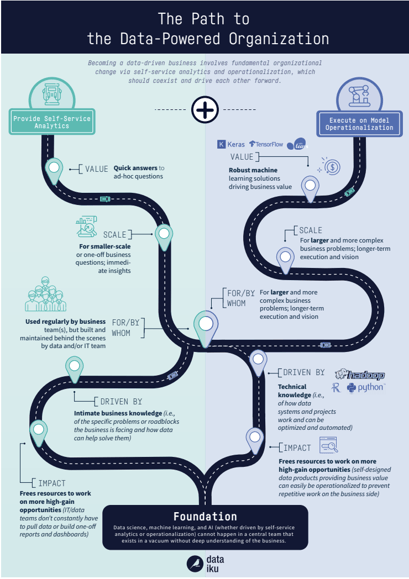Many organizations with the hope of becoming more data-driven ask the question: self-service analytics, or data science operationalization - which will get me where I need to be? And the answer is: you need both together.

Why? Read the details in the latest white paper Enabling AI Services Through Operationalization + Self-Service Analytics. Or find out where you stand on the path to Enterprise AI by taking the quiz.

The Road to Data Dominance
The fact is, the interplay and balance between operationalization (o16n) and self-service analytics (SSA) initiatives that makes a successful data-powered company that executes on all projects to its fullest potential. While at first glance the two appear to be completely different (maybe even contradictory), it’s precisely because they differ in value, scale, and more that they round out a complete data strategy.
(Click to see the full-size infographic)

SSA is useful because it ensures wide coverage of an organization’s data initiative. It is more bottom-up, and it puts data in the hands of everyone at the organization, empowering them to use it to drive day-to-day decisions. While organizations that rely only on SSA are agile and can answer quick, small-scale questions, they may lack the larger picture; that is, a focus on bigger business questions and problems that have opportunity to make the large-scale changes and projects driven by machine learning or AI.
By contrast, o16n is what ensures depth. It is more top-down - it’s all about answering large, strategic business questions and needs to make sweeping change through large-scale data projects. But companies that rely only on o16n may lack the smaller-scale agility and ability for any employee to seek answers through data.
Keys to Execution
For a complete list of the common pitfalls in implementing o16n and SSA, as well as steps to execution (both on a tactical level as well as from the perspective of organizational structure), get the latest white paper Enabling AI Services Through Operationalization + Self-Service Analytics.
Or, if you’re not sure where you stand now, take the quiz first to see what stage of development your organization is on the path to Enterprise AI.
